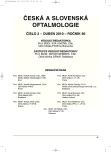Treatment of Angioid Streaks with Bevcizumab
Authors:
M. Černák 1; O. Markovic 2; A. Černák 1
Authors‘ workplace:
Očná klinika SZU, Bratislava, prednosta prof. MUDr. Andrej Černák, DrSc., 2Očná klinika AKH, Linz, prednosta doc. Prglinger Siegfried M. D.
1
Published in:
Čes. a slov. Oftal., 66, 2010, No. 2, p. 72-75
Overview
Purpose:
To evaluate the possibility to treat the chorioidal neovascularisation in angioid streaks with the help of Bevacizumab. Chorioidal neovascularisation is here the main reason responsible for destroying the vision and affects about 70–85% of patients with this disease. Material and methodic: 50 years old woman with 2 weeks anamnesis of worsening of vision on left eye. She claims deformed view in the middle of the visual field and mild decrease of visual acuity. BCVA was 0.9 and examination with Amsler grid showed line distorsion in the central part. After fundus examination, angiography and OCT we set diagnosis: angioid streaks complicated by subfoveal chorioidal neovascularisation. We proposed patient treatment with intravitreal Bevacizumab and subsequently started the therapy.
Results:
one week after bevacizumab application, patient claims vanishing of vision distortion. In four weeks metamorphopsis completely disappeared and BCVA reached 1.2. OCT and FAG showed less leakage. After initial improvement and 7 months of standstill there comes again to vision deterioration (BCVA 0.7). We were obliged to reinject 1.25 mg of Bevacizumab and VA improved to 0.9 and also the deformation was less. Three months after second injection VA was again decreased and patient was treated with third injection. Patient is followed up for period of 12 months with mild deformation of picture and VA 0.7. It was not observed any side effect of treatment.
Conclusions:
The treatment of the chorioidal neovascularisation in angioid streaks is another possibility with the help of Bevacizumab.With this treatment can be delayed the devastation of VA with subfoveal neovascularization. It seems that the treatment is only temporaly and during the 12 months follow up came to a few relapse.
Key words:
angioid streaks, bevacizumab, subfoveal neovascularization.
Sources
1. Bhatnagar, P., Freund, K.B. Spaide R.F., et al.: Intravitreal Bevacizumab for the Management of Choroidal Neovascularization in Pseudoxanthoma Elasticum, Retina, 27, 2007; 7: 897–902
2. Cakir, M., Cekic, O., Yilmaz, F.: Intravitreal bevacizumab for idiopathic choroidal neovascularization, Journal of American Association for Pediatric Ophthalmology an Strabismus, 13, 2009; 3: 296–298
3. Clarkson, J.G., Altman, R.D.: Angioid streaks, Surv. Ophthalmol., 26, 1982; 5: 235–246
4. Doyne, R.W.: Choroidal and retinal changes the results of blows on the eyes, Trans. Ophthal, 1889, 9: 128
5. Gelisken. O., Hendrikse, F., Deuman, A.F.: A long-term follow-up study of laser coagulation of neovascular membrane in angioid streaks. Am J. Ophthalmol., 105; 1988; 299–303
6. Hagedoorn, A.: Angioid streaks, Arch Ophthalmol., 1939, 21, 746–774
7. Knap, H.: On the formation of dark angioid streaks as an unusual metamorphosis of retinal hemorrage. Arch. Ophthal., 1892, 21: 289–292
8. Lee, J.M., Nam, W.H., Kyoung Kim, H.: Photodynamic Therapy With Verteporfin for Choroidal Neovascularization in Patients with Angioid Streaks, Korean J Ophthalmology, 21, 2007; 3: 142–145
9. Lim, J.I., Bressler, N.M., Marsh, M.J. et al.: Laser treatment of choroidal neovascularization in angioid streaks, Am. J. Ophthalmol., 116; 1993; 414–423
10. Liu, Y.CH., Yang, Ch. S., Shyong, M.P. et al.: Intravitreal Injection of bevacizumab for the Treatment of Choroidal Neovascularization in a Patient with Angioid Streaks, Journal of Chinese Medical Association, 72, 2009; 2: 98–102
11. Pece, A., Avanza, P., Galli, N. et al.: Laser photocoagulation of choroidal neovascularization in angioid streaks, Retina, 17; 1997; 12–16
12. Sachdev, N., Vishawanathan, K., Gupta, V. et al.: Intravitreal bevacizumab (Avastin) in choroidal neovascular membrane in angioid strreaks, Indian Journal of Ophthalmology, 55, 2007; 6: 457–458
13. Schargus, M., Cuthoff, R., Keilhauer, C. et al.: Photodynamische Therapie mit Verteporfin bei klassischer chorioidaler neovaskularisation bei Patienten mit Angioid Streaks, Klinische Monatsblätter fűr Augenheilkunde, 223, 2006; 12: 987–992
14. Spaide, R.F., Martin, Melissa, L.B.S., Slakter, J. et al.: Treatment of idiopathic subfoveal choroidal neovascular lesion using photodynamic therapy with verteroporfin, American Journal of Ophthalmology, 134, 2002; 1: 62–68
15. Wiegand, T.W., Rogers, A.H., McCabe, F. et al.: Intravitreal bevacizumab (Avastin) treatment of choroidal neovascularisation in patients with angioid streaks, British Journal of Ophthalmology, 93, 2009; 47–51
Labels
OphthalmologyArticle was published in
Czech and Slovak Ophthalmology

2010 Issue 2
Most read in this issue
- The Use of Modern Examination Methods in Early Diagnosis of Pigmentary Glaucoma and Pigmentary Dispersion Syndrome
- The ERG Contribution in Early Diagnosis of Chloroquine and Hydroxychloroquine Maculopathy
- Implantation of the Stenopeic Aniridiae Posterior Chamber Intraocular Lens after the Trauma – Yes or No?
- The Influence of the Idiopathic Macular Hole (IMH) Surgery with the ILM Peeling and Gas Tamponade on the Electrical Function of the Retina
